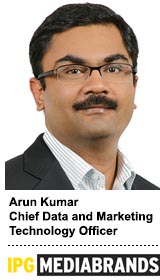
For agencies, managing and optimizing campaigns across walled gardens is no easy task.
Because Facebook, Google, Snap, Twitter and Amazon each have their own ways of defining audiences and processes for optimizing spend, buyers have to launch campaigns multiple times across each of them for every client, without getting consistent insight into what’s working and what’s not.
It’s not the most efficient process or the best use of agency talent, but clients need to be on these platforms, and agencies have had no choice but to play by their rules.
But IPG Mediabrands’ chief data and marketing technology officer, Arun Kumar, saw that the tedium of buying across walled gardens was impeding his team’s ability to quickly and efficiently optimize campaigns.
“I can’t keep asking my teams to set up every campaign three or four or six times,” said Kumar, who also oversees performance marketing agency Reprise and programmatic hub Cadreon within Mediabrands. “I need to [be able to] set it up once, fix the parameters and connect into all of the platforms.”
To get around those inefficiencies, Kumar and his team began building functionalities on top of a Cadreon tool called Unity, built two years ago to optimize programmatic buys across DSPs and exchanges. Mediabrands began integrating Unity, which is still in development, with more platforms, including its internal data stack, called AMP, a few publisher private marketplaces and walled gardens including Google, Facebook and Amazon.
“Unity is a shell which allows us to connect our solutions internally and with third parties,” Kumar said. “It’s an attempt to connect all of the disparate parts of the ecosystem.”
Unity’s integration with AMP, which creates audiences by stitching online and offline data sets to universal IDs from Acxiom, allows Mediabrands to deploy its own definition of audiences across platforms. That offers a layer of identity consistency buyers can’t usually get when buying across walled gardens.
“Today, planning defines an audience and then buyers redefine that audience in different ways across platforms,” Kumar said. “We’re trying to bring the audience piece upfront. Whether it’s Cadreon or UM, all [agencies] have the same understanding of the audience.”
By automating campaign setup and optimization across platforms, Unity frees time for Kumar’s team to make optimizations faster, which in turn leads to better-performing campaigns and more efficient investments. Its ability to deploy and optimize campaigns horizontally gives Mediabrands more insight into the nuances between platforms, like which segments perform better on which platforms.
“I’m going to [be able to] act faster than anybody else, and I’m going to do it in a much more efficient way because I’ve automated the entire thing,” Kumar said.
Today, Mediabrands deploys Unity in bespoke cases for IPG clients, although Kumar declined to say how many clients are using the tool or how much spend runs through it. Eventually, Mediabrands wants Unity to become an operating system used across IPG’s agencies and to sell it to external clients.
Kumar declined to say how clients pay for the tool or whether they must buy media through IPG to use it.
Because Unity is deployed in a bespoke way for each client and vertical, it’s difficult to dive into results without violating client NDAs. For Kumar, the main measure of success is how much faster the platform allows his team to deploy, manage and optimize campaigns.
“Speed is a function of how smooth and seamless the ecosystem works,” he said. “If it’s broken, it’s going to take you a longer time to make changes. Unity enables us to learn faster. Because we learn faster, the campaigns typically perform far better.”
While Unity is proprietary to Mediabrands, it wouldn’t have been possible to build without close cooperation with partners like Facebook and Google, which is part of the reason the platform has remained under wraps. Kumar declined to specify whether Unity has access to all walled-garden inventory or just a reserved selection.
“There’s a lot of moaning about the walled gardens, but if you look at it from their perspective, each has something really rich and quite unique,” Kumar said. “The objective is not to commoditize them, but to make it easier for us to leverage their strengths.”
Facebook’s and Google’s willingness to work with Mediabrands offers hope to agencies that there may cracks in the storied garden walls. After a year of measurement mess-ups, a brand safety fiasco and a fake news crisis, Facebook and Google may be realizing it’s time to offer more insights to the industry that funds their multibillion-dollar businesses.
Despite these new levels of collaboration, however, Mediabrands still isn’t getting any data out from behind the garden walls.
“We’re not pulling data out from these ecosystems,” Kumar said. “We’re not using Facebook data to target across Google. We’re optimizing within walled gardens.”
This post was syndicated from Ad Exchanger.

More Stories
The Tuesday Club hosts Women’s Work’s In(visible) exhibition in Tāmaki Makaurau
Under Armour Taps Estée Lauder Exec to Lead AI and Analytics
Lani Jamieson joins D3 to shape the next chapter of its growth